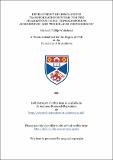Files in this item
Development of homologous transformation systems for the filamentous fungi 'Cephalosporium acremonium' and 'Penicillium chrysogenum'
Item metadata
| dc.contributor.advisor | Kinghorn, Jim | |
| dc.contributor.author | Whitehead, Michael Phillip | |
| dc.coverage.spatial | 201 p. | en_US |
| dc.date.accessioned | 2018-06-19T13:19:36Z | |
| dc.date.available | 2018-06-19T13:19:36Z | |
| dc.date.issued | 1991 | |
| dc.identifier.uri | https://hdl.handle.net/10023/14259 | |
| dc.description.abstract | Spontaneous chlorate resistant mutants of Penicillium chrysogenum and Cephalosporium acremonium have been isolated. Putative genotypes of the P. chrysogenum mutants were identified using the phenotypic characterization of Cove (1979). This analysis was also attempted with C. acremonium, however it was found that the wild type organism could not grow on minimal media containing glucose and hypoxanthine and thus cnx and niaD mutants could not be differentiated using this method. Following the distinction of cnx and niaD mutants using cytochrome C reductase and purine hydroxylase I assays, a simple plate test using minimal media containing quinic acid as carbon source and inosine as nitrogen source was developed to analyse cnx and niaD mutants. Nonreverting (at less than 1 in 108) niaD mutants were isolated for later experiments. P. chrysogenum niaD mutant niaD19 was transformed to nitrate utilization at a frequency of up to 20 transformants/mug DNA using the Aspergillus nidulans niaD gene, up to nine/mug DNA with the A. niger niaD gene and up to three/mug DNA using the A. oryzae niaD gene. Vector constructs carrying the A. nidulans ans-1 sequence with the A niger niaD gene did not show increased transformation efficiency. Linearization of the A. niger niaD containing plasmid resulted in a two to three times increase in transformation frequency. Southern blot hybridization analysis demonstrated that vector sequences had integrated into the recipient genome. The control of heterologous niaD gene expression generally agreed with that found in the wild type strain, that is, induction by nitrate and repression in the presence of ammonium. The A. nidulans, A. niger and A. oryzae genes failed to transform C. acremonium niaD mutants. A DNA fragment containing the C. acremonium niaD gene was isolated by cross hybridization to the A. nidulans niaD gene. This fragment was sub-cloned into pUC18 (designated pSTA700), and showed back hybridization to C. acremonium wild type DNA exhibiting the expected hybridization pattern. When partially sequenced, it showed nucleotide and determined amino acid homology to the A. nidulans niaD gene and protein. The clone pSTA700 transformed a C. acremonium niaD mutant, CSG116 and P. chrysogenum STP19 to nitrate utilization at a frequency of up to 47 and six transformants/mug DNA, respectively. When heat shock was applied to C. acremonium protoplasts 10mins prior to the addition of DNA, transformation frequencies of up to 137/mug DNA were obtained. Southern analysis of transformants revealed multiple integration of vector sequences, with no detectable preference for the homologous niaD site. Some C. acremonium transformants showed a greatly increased nitrate reductase activity (up to 10 times wild type activity) when induced with nitrate. The niaD transformation system was successfully used to introduce unselected markers into C. acremonium such as hygromycin B and benomyl resistance. The co-transformation frequency was up to 25% when equal molar ratios of plasmids were used. Antibiotic biosynthetic genes isolated from C. acremonium (pcbC and cefEF) and A. nidulans (pcbC and penE) were introduced into C. acremonium CSG116 by co-transformation with the C. acremonium niaD gene or the construction of vectors containing both the C. acremonium niaD gene and antibiotic biosynthetic genes. Isolates transformed with the C. acremonium pcbC and cefEF genes exhibited an increase in antibacterial activity (greater than 20% compared to wild type) at frequencies of up to 10% and six percent of transformants, respectively. When A. nidulans constructs containing the pcbC and penE genes, but not the pcbC gene alone, were co-transformed into C. acremonium, up to 18% of transformants exhibited an increase in antibacterial activity. The presence of penicillin antibiotics could not be found in these transformants and thus the exact cause of this increase in antibacterial activity could not be determined. | en_US |
| dc.language.iso | en | en_US |
| dc.publisher | University of St Andrews | |
| dc.subject.lcc | QK623.A2W5 | en |
| dc.subject.lcsh | Funghi | en |
| dc.title | Development of homologous transformation systems for the filamentous fungi 'Cephalosporium acremonium' and 'Penicillium chrysogenum' | en_US |
| dc.type | Thesis | en_US |
| dc.type.qualificationlevel | Doctoral | en_US |
| dc.type.qualificationname | PhD Doctor of Philosophy | en_US |
| dc.publisher.institution | The University of St Andrews | en_US |
This item appears in the following Collection(s)
Items in the St Andrews Research Repository are protected by copyright, with all rights reserved, unless otherwise indicated.

